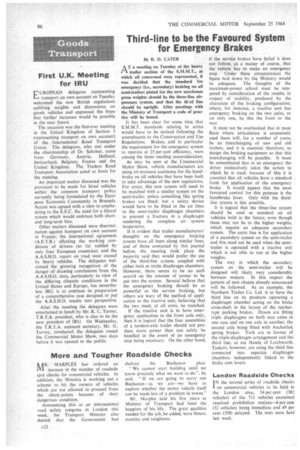Third-line to be the Favoured System for Emergency Brakes
Page 90

If you've noticed an error in this article please click here to report it so we can fix it.
By R. D. CATER
AT a meeting on Tuesday of the heavy trailer section of the S.M.M.T., at which all concerned were represented, it was decided that the standard for emergency (i.e., secondary) braking on all semi-trailers plated for the new maximum gross weights should be the three-line airpressure system, and that the th.rd line should be upright. After meetings with the Ministry of Transport a code of practice will be issued. It has been clear for some time that S.M.M.T. standards relating to artics would have to be revised following the amendments to the Construction and Use Regulations. Brakes, and in particular the requirement for the emergency system to operate at 25 per cent efficiency, were among the items needing reconsideration. As may be seen at the Commercial Motor Show, vehicle manufacturers are using air-pressure assistance for the handbrake on all vehicles that have been built to take advantage of the new regulations. For artics, this new system will need to be matched with a similar system on the semi-trailer, unless something like spring brakes are fitted; but a safety device would have to be fitted in the air lines to the semi-trailer diaphragm chambers to prevent a fracture in a diaphragm rendering the complete air system inoperative. It is evident that trailer manufacturers' thoughts on the emergency braking system have all been along similar lines, and of those contacted by this journal before the meeting took place the majority said they would prefer the use of the third-line system, coupled with either twin or triple diaphragm chambers. However, there seems to be no such accord on the amount of power to be put into the system. Several believe that the emergency braking should be as powerful as the service braking, but others are wary of the method of application to the tractive unit, believing that the two must, at all costs, be matched. If the tractive unit is to have emergency application to the front axle only, then it is logical that the four assemblies of a tandem-axle trailer should not produce more power than can safely be handled in the event of an emergency stop being necessary. On the other hand, if the service brakes have failed it does not follow, as a matter of course, that the vehicle has to make an emergency stop. Under these circumstances the figure laid down by the Ministry would be adequate. The thoughts of the maximum-power school must be tempered by consideration of the results, in respect of stability, produced by the alteration of the braking configuration; where, for instance, a tractive unit has emergency braking on the two axles, or on only one, be this the front or the rear.
It must not be overlooked that in most fleets where articulation is extensively used there will, for a number of years, be an interchanging of new and old trailers, and it is essential therefore, to design the braking equipment so that this interchanging will be possible. It must be remembered that in an emergency the driver instinctively takes the action to which he is used; because of this it is essential that all vehicles have a standard form for application of the emergency brake. It would appear that the most favoured control for this purpose is the handbrake lever. Only with the thirdline system is this possible. It is logical that the three-line system should be used as standard on all vehicles built in the future, even though these may not be to the higher weights, which require an adequate secondary system. The extra line is for application of a secondary system on the semi-trailer and this need not be used when the semitrailer is operated with a tractive unit which is not able to run at the higher weights. • The way in which the secondary system on the semi-trailer will be designed will likely vary considerably between makers. In this respect the pattern of new chassis already announced will be followed. As an example, the Northern Trailer Co. Ltd. is to have the third line on its products operating a diaphragm chamber acting on the brake cross-shaft in the layout of the ratchettype parking brakes. Dyson are fitting triple diaphragms on both rear axles in one case and on one axle in another, the second axle being fitted with Anchorlok spring brakes. York are in favour of the triple-diaphragm arrangement and the third line, as are Hands of Letchworth. Taskers, however, are using the third line connected into separate diaphragm chambers independently finked to the brake cam levers.
London Roadside Checks IN the second series of roadside checks on commercial vehicles to be held in the London area, 54 per cent (382 vehicles) of the 713 vehicles examined received prohibition notices-4 per cent (32 vehicles) being immediate and 49 per cent (350) delayed. The tests were held last week.






































































































































































































































































































































































































